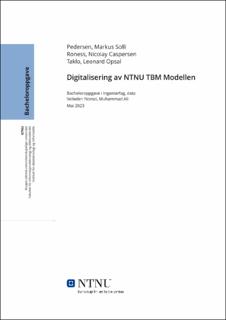| dc.description.abstract | Denne bacheloroppgaven handler om å digitialisere doktoravhandlingen "Hard Rock Tunnel Boring: Performance Predictions and Cutter Life Assessment" av Francisco Javier Macias. NTNU-modellen for TBM (Tunnel Boring Machine) er en matematisk modell for TBM-prosjekter i harde bergarter. Modellen tar utgangspunkt i empirisk data fra tunnelprosjekter og beskriver hvordan forskjellige maskin- og geologi-parametere har en effekt på maskinens fremdrift og levetiden på kutterene. Fra før av finnes det programvare for modellen, men denne programvaren er enten utdatert, mangler ønsket funksjonalitet eller gjør feil i beregninger. Å digitalisere modellen har som mål å bespare tid i utregninger, gi mer pålitelige resultater, gjøre det enklere å samarbeide i TBM-prosjekter og bruke modellen i undervisningsammenheng.
Gjennom bruk av den iterative utviklingsmetodikken Scrum og utviklingsmetoder som wireframing og prototyping har gruppen utviklet en webapplikasjon med blant annet Vue, Typescript, Java, Spring Boot og MySQL. Applikasjonen som er utviklet støtter et brukersystem, prosjektsystem, e-post, norsk og engelsk språkstøtte og administrering av parametere, språk og brukere. Implementasjonen av NTNU-modellen står som den sentrale delen av systemet og består av 81 parametere med 49 tilhørende matematiske funksjoner hvor en endring av et parameter forplanter seg gjennom systemet og viser den oppdaterte modellen. For å bestå kravet om å være en sikker og brukervennlig applikasjon er den evaluert med WCAG og OWASP Top 10, og for å sikre at modellen gir pålitelig resultater har de matematiske funksjonene en testdekning på 84%.
Systemet som er utviklet i tett samarbeid med produkteier kan anses som komplett og pålitelig både i opplæringssammenheng og for bransjen generelt. Denne rapporten beskriver relevant teori for å forstå problemstillingen og resultatet av denne. Til tross for et system som stort sett består kravene i henhold til visjonsdokumentet gjenstår det fortsatt videre arbeid med applikasjonen som implementasjon av usikkerhet og kostnadsberegninger. | |
| dc.description.abstract | This bachelor thesis focuses on digitizing the doctoral dissertation "Hard Rock Tunnel Boring: Performance Predictions and Cutter Life Assessment" by Francisco Javier Macias. The NTNU-model for TBM (Tunnel Boring Machine) is a mathematical model for TBM-projects in hard rock formations. The model is based on empirical data from tunnel projects and describes how various machine and geological parameters affect the machine's progress and cutter life. Existing software for the model is either outdated, lacks desired functionality, or contains calculation errors. The goal of digitalizing the model is to save time in calculations, provide more reliable results, facilitate collaboration in TBM projects, and to use the model for educational purposes.
Using the iterative development methodology Scrum and development techniques such as wireframing and prototyping, the group has developed a web application using technologies like Vue, Typescript, Java, Spring Boot, and MySQL. The developed application supports user management, project management, email notifications, Norwegian and English language support, and administration of parameters, languages, and users. The implementation of the NTNU model is the central part of the system, consisting of 81 parameters with 49 associated mathematical functions. Any change in a parameter propagates through the system, reflecting the updated model. To meet the requirements of being a secure and user-friendly application, the applications has been evaluated with WCAG and OWASP Top 10. In order to ensure reliable results from the model, the mathematical functions has a test coverage of 84%.
The system, developed in close collaboration with the product owner, can be considered complete and reliable, both for educational purposes and for the industry in general. This report describes the relevant theory to understand the problem statement and presents the results. Despite the system largely meeting the requirements outlined in the vision document, further work still remains, particularly regarding the implementation of uncertainty and cost calculations. | |

